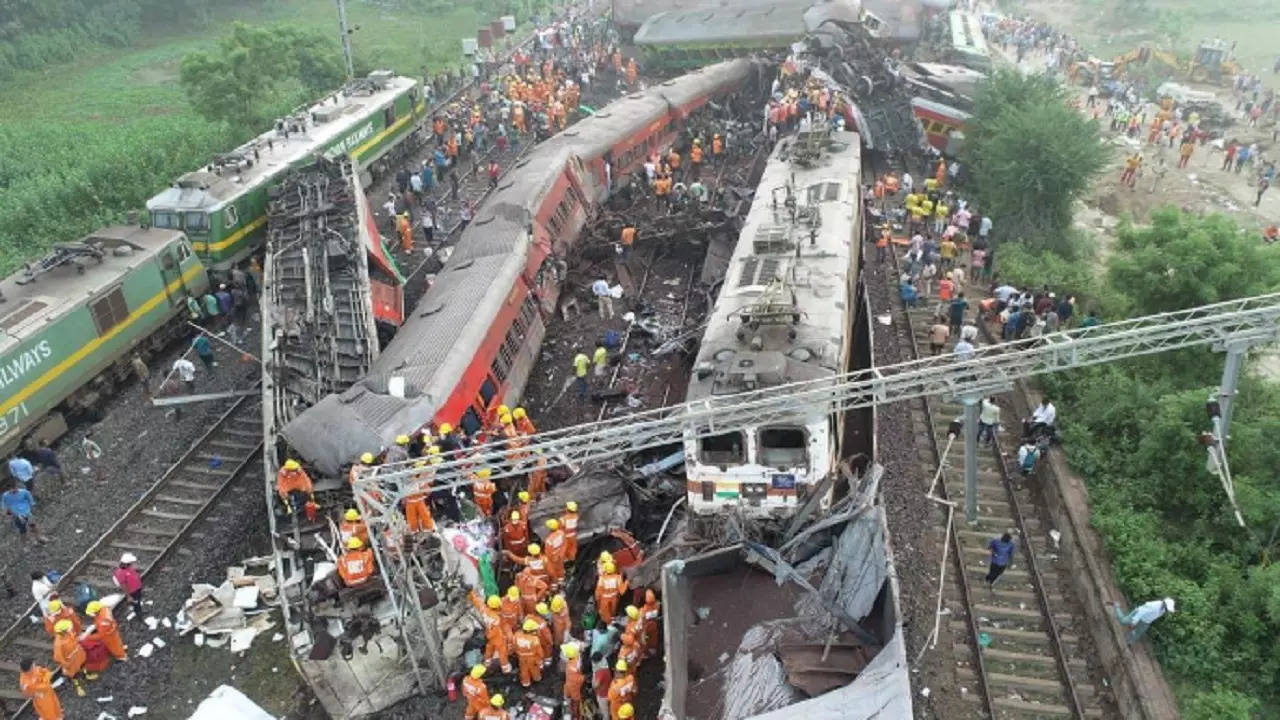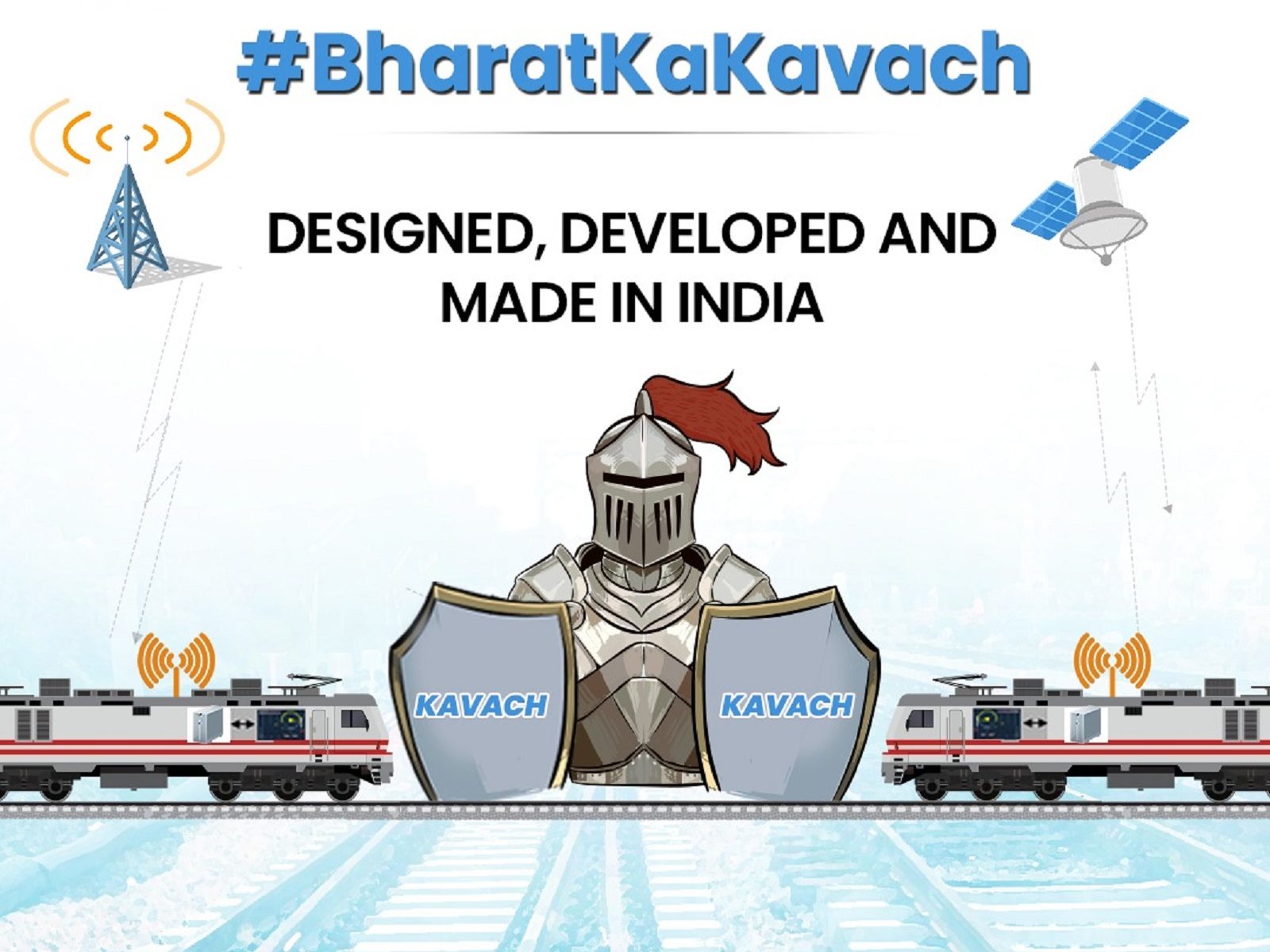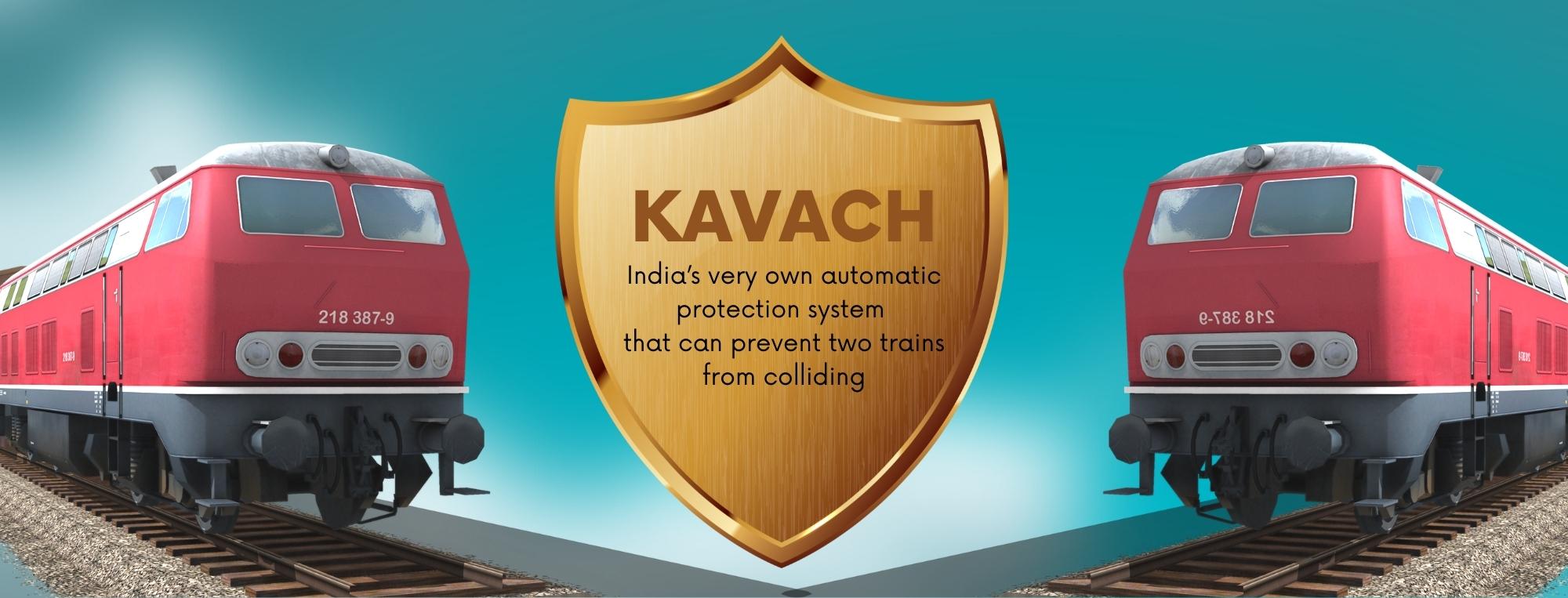Kavach- Train Protection System: Does It Genuinely Act As A “Kavach” For Indian Railways?
Only 2 percent of all Indian trains have Kavach System installed, while there assertions that Kavach could not have prevented Odisha accident.

Kavach and its Relevance
Three trains crashed one following the other in the Balasore region of Odisha, resulting in one of the deadliest railway accidents to ever happen in India, killing more than 238 people and injuring more than 900 others. All of this occurs while Modi has been busy in recent months launching Indian-built high-speed trains on what is one of the most extensive rail networks in the world, which is nevertheless overcrowded due to a dearth of adequate dedicated freight routes.
India, a nation that is proud of the installation of sophisticated locomotives, has fantasies of fast trains, and devotes record amounts of revenue to its railway network, is shocked by this three-way train crash which has killed hundreds and is thought to be the biggest train tragedy in 20 years.
The Kavach system, which was designed to make rail travel secure and was supposed to be implemented by the Central government, came under scrutiny shortly after word of this horrifying train catastrophe broke on the evening of June 2. After more than ten years after its conception, the Union administration has come under fire from politicians in opposing parties for its massive delay in deploying Kavach, an autonomous railway safety system.

How many trains have Kavach system in India?
Congress asserts that just 2% of all trains in India are equipped with the Kavach protection mechanism. The Indian Railways operate over 13,169 passenger trains daily, but only 65 locomotives, 1445 kilometers of tracks, and 134 stations are now equipped with the Kavach system.
The South-Central Railway zone, which includes Maharashtra, Telangana, Karnataka, and Andhra Pradesh, is the only area where Kavach is presently in use. As a component of Mission Raftaar, it is additionally being carried out on the key lines between Delhi and Mumbai as well as Delhi and Howrah.
The current Train Collision Avoidance System (TCAS), which was implemented by the Railway Ministry under the supervision of Mamata Banerjee in 2011–12, was assigned the name Kavach by the Modi administration in 2020.
It was said that the system will encompass more than 35,000 kilometers of railway track when it was adopted as the National Automatic Train Protection System in July 2020. However, critics highlight that not much has changed in the system’s implementation throughout the years.
On March 29, 2023, Railway Minister Ashwini Vaishnaw responded to inquiries concerning Kavach in Parliament sessions by stating that just 1,455 km of the train route, of which 576 km are in the state of Maharashtra, had seen Kavach deployment. However, it appears that between August 2022 and March 2023, barely anything was accomplished. A total of fewer than 400 kilometers had been brought under Kavach from March to August 2022.
The Minister reported to the Parliament on March 23, 2022, that 1,098 km of the South Central Railway had been finished. The delay is a result of the necessity of scaling up Kavach technology production, which requires expenditures which takes time. According to a senior rail official, it is going to take a few years at least to fully implement Kavach.
Mamata Banerjee, the chief minister of West Bengal as well as the minister of transportation at the point in time TCAS was introduced, criticized the absence of anti-collision equipment on the railways. She said that if there had been an anti-collision mechanism on the rails, the incident could not have happened.
Saket Gokhale, a spokesperson for the Trinamool Congress, questioned why Kavach had only been used on a tiny portion of all Indian railroad rails. The Modi government is surprisingly fixated on launching additional Vande Bharat high-speed trains, the majority of which are directly inaugurated by PM Modi, despite the fact that anti-collision devices are absent from 98% of Indian Railways routes.
On a 98% anti-collision technology-deficient railway network, new high-speed trains are being introduced. What may possibly fail? According to a tweet from Saket, a working anti-collision mechanism may have stopped the terrible train catastrophe that occurred in Balasore, Odisha.

What is Kavach?
To increase the safety of moving trains, Indian Railway created an in-house Automatic Train Protection (ATP) System named Kavach. It was created locally by RDSO in collaboration with 3 Indian vendors.
KAVACH could assist the loco pilot prevent Signal Passing At Danger (SPAD) and excessive speeding in addition to assisting with train operation in bad weather conditions including dense fog. Kavach will thereby improve the security and effectiveness of railway operations.
The key characteristics of the aforementioned Kavach system include the following:
- Kavach regulates train speed by automatically applying the brakes in the event that the Loco Pilot is unable to do so.
- Repeats the line-side signal in the cab, which is extremely beneficial at high speeds and in foggy conditions.
- Works on the idea of continual movement authority updating.
- Whistling at the LC gates.
- Direct loco-to-loco communication is used to avoid collisions.
- Supports the SOS function for controlling trains in the neighborhood in the event of a catastrophe.
How does Kavach work?
Kavach is a type of ‘Traffic Collision Avoidance System,’ or TCAS, that is used to avoid collisions between two cars. In order to accomplish this, the system measures the gap separating the trains as well as the pace with which it varies. The Kavach system includes amenities which show details such as speed, position and distance to the next signal, signal kind, emergency communications from the pilot or station, among others.
The rails are outfitted with radio-frequency identification (RFID) tags which transmit data straight to the Loco (locomotive) TCAS unit within the train. The train’s trajectory and velocity are determined by the unique IDs allocated to different parts of the railway.
From the beginning of the 1980s, TCAS has been extensively utilized in airplanes to lessen mid-air accidents. According to media accounts, TCAS was turned on in 2019 to prevent a mid-air crash involving a Boeing as well as an Airbus over Mumbai skies by allowing one of the aircraft to rapidly ascend upwards.
Similar to this, the Kavach system identifies the approach of two trains that are traveling head-on in the same direction and immediately deploys the brakes. Additionally, it warns the driver or loco pilot about taking over train operations. In order to communicate with neighboring locomotives, stations with radio towers have a Stationary TCAS unit installed. The front and back ends, the top, certain wheels, and other locations within a locomotive are all equipped with sensors.
It is possible to determine a train’s direction and speed by timing the passage of two RFID tags. Using an ultra-high frequency (UHF) radio antenna, the Loco TCAS unit transmits data regarding the train while it crosses a section to the Stationary TCAS unit situated at the station.
The train will slow down and halt if its approaching sign is red, which the Stationary TCAS will communicate to the Loco TCAS. Automatic brakes are used in the event the loco pilot fails to stop the vehicle. The Stationary TCAS device shall use the most stringent criteria and limit train movement whenever there is any disagreement between signals from multiple locations or sequences.
SOS signals, combined with visible and audible warnings to the drivers, are given to each of the trains from the station whenever two trains are traveling in the same direction on the same track. This instantly stops both trains. The Kavach system engages to guarantee a safe gap of a minimum of 300 meters continues to exist when both trains arrive to a complete stop, based on the speed of the trains as well as the distance that exists between them.
According to a formal paper pertaining to the Kavach system provided by the Indian railroads, there is additionally a centralized surveillance of TCAS measures in the works, in addition to a variety of additional failsafe and fallback security measures that would be put into operation to prevent collisions.

Could Kavach have prevented Odisha collisions?
Three trains had been involved in the accident and derailing in Odisha. A improper track change that resulted in a collision and the derailment of every one of the trains caused the collision. The disaster in Odisha was unusual. The remaining three bogies in the Bengaluru-Howrah express could have sailed through without incident had there been a 30 to 40 second postponement.
Kimbahune, who collaborated closely alongside the government at the national level for the Centre for Railway Information Systems (CRIS) throughout the installation of satellite communication (satcom) monitoring in trains, clarified that it was undesirable that the Coromandel Express’ derailed bogies struck the Bengaluru-Howrah express. He continued by saying that Kavach could not have prevented the derailment, hence the catastrophe would not have been avoided.
The system also required Kavach to operate, but none of the two trains that were travelling in the same direction had it. Additionally, the trains were moving at legal speeds, which prevented the brakes from activating.
Most crucially, though, the Coromandel Express was rerouted into a loop route where a stalled engine was resting despite the fact that the mainline signal remained green for the two trains. Kavach is not intended to recognize and respond to monitor alignment adjustments or interlock problems.
Vivek Kimbahune, executive vice-president of Bengaluru-based Saankhya Labs, who provided satellite communications technology for actual time train surveillance, backed up his assertion. This satellite communication network is responsible for real-time train tracking data on the National Train Enquiry System (NTES) available on monitoring websites. According to him, the Kavach system’s weakness is that it is fully operational and beneficial only when the whole railway system is upgraded, featuring every locomotive fitted with Kavach.
Kimhabune had also stated that Kavach demands a minimum space for a locomotive to slow down until coming to a full halt. Considering the distance and pace on the loop in Odisha, it probably might have been impossible to get the loco pilot to respond or for the technology to securely bring the train to a complete halt.
However, Kimbahune said that until the whole inquiry is finished, most assumptions as to the reason of the disaster and how it may have been avoided are speculative. Regardless of whether Kavach had been operational on the route, the Coromandel three-train catastrophe could not have been prevented, according to Jaya Varma Sinha, Member of Operation and Business Development, Railway Board.
If an impediment suddenly appears in front of a fast-moving car, no technological innovation in the world, according to Jaya Varma, will avoid an accident. A comprehensive investigation would disclose if the interruption had ben manual, due to weather, or something else, Sinha noted, emphasizing the likelihood of failures of equipment for all electronics systems.
She also stated that the technology is intended to detect cases in which a locomotive pilot skips a signal, a condition referred to as Signal Passed at Danger (SPAD), that happens to be one of the leading causes of railway collisions. When the system detects a second train within a specified distance on the exact same track, it immediately warns the locomotive pilot, assumes command of the braking systems, and promptly puts the train to an immediate halt.
According to reports, Kavach’s braking mechanism should have halted the Bengaluru-Howrah Express. According to a railway official, Kavach requires one kilometer of preceding response time considering the locomotive’s estimated speed of 120km/h. When questioned why the execution of the plan has been so sluggish, the official explained that manufacture for the Kavach system had to be cut back. This requires investment. According to the source, it will take several years to deploy throughout all tracks.
Furthermore, it cannot be argued that in the event the track as well as train had been armed with Kavach, the likelihood of a crash between two trains could have been much reduced, if not entirely avoided. If the two trains were equipped with such technology, the anti-collision system could have decreased train pace and averted a collision. Furthermore, the locomotive might not have reached the loop line since another locomotive (a goods train) had previously arrived there, alerting the loco pilot. A loop line constitutes a locomotive branch line that departs from and returns to the main line following a brief distance. According to sources, the Coromandel Express went into the loop line and crashed with the cargo train.
However, there exists a catch. Sudhanshu Mani, former general manager at Integral Coach Factory, believes Kavach may have saved the day if the locomotive’s pilot had missed the signal. Then it could have stepped in, controlling the train’s speed and bringing it to a halt. However, if the locomotive derailed and its bogies fell into other track, Kavach could have proven to be of little use, he claims. It happens because the railway will have generally short-circuited as a result of the train’s effect on it, destroying its signals and failing to warn of an impending train.
Kavach relies on electrical and radio frequency equipment put on trains, tracks, and railway signaling systems. Kavach may track impediments on a track if they have not harmed the track in some way. In such instances, the train’s pilot’s visual recognition would aid in avoiding a crash. In this occasion, it’s uncertain if the Coromandel Express collided with a cargo train on the same track or derailed.

Difference between claims and reality
Vaishnaw described Kavach as an exceptionally advanced system and claimed it to be superior compared to the European Train Control System (ETCS) utilized throughout the globe, at the 2023 Global Business Summit. He asserted at the time they chose to create and build the system here, which must be simple, replicable, and portable. When compared to the European system, these are superior to ECTS Level 2.
There are now justifications for why this train disaster could not have been prevented, even if the Kavach system had been in place. It makes no sense to make these kinds of assertions while also claiming to be superior to ETCS. The government must begin accepting responsibility for its actions and the impact that they are having on the nation and its people. When one of the nation’s oldest industries—the Railways—is in such a dire state, PM Modi should stop making people dream of futuristic bullet trains and other transportation innovations.
Published By Naveenika Chauhan




